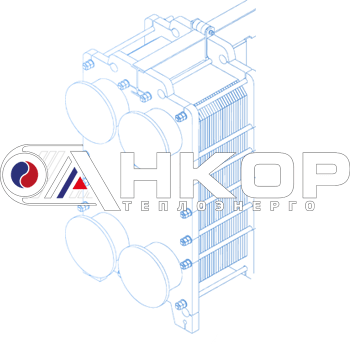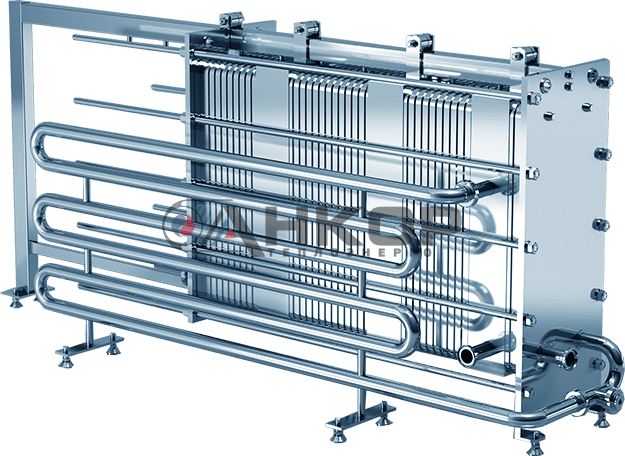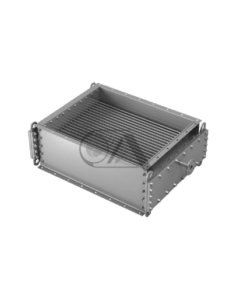Gasketed plate heat exchangers
An important part of the products manufactured by Ankor-Teploenergo is a classic gasketed plate heat exchanger. This type of units is widely used in various types of manufacture and is one of the most common types of heat exchange equipment. Having the simplest and most compact design and at the same time being easy to use, gasketed plate heat exchangers do not become relevant. Also, they are provided with possibility of mechanical cleaning for both working fluids. One of the main advantages is also the complete interchangeability of any structural element. This allows you to make repairs as soon as possible and without a lot of labour. In addition, there is an option to increase power by increasing the number of plates on the frame. As for the material design, having a full manufacturing cycle, including a press workshop section for plate stamping and a rubber goods department for manufacturing gaskets, Ankor-Teploenergo can stamp from various materials, from AISI 304 and AISI 316 stainless steels to high-alloy hastelloy and even titanium. In total, there are more than 40 standard sizes manufactured by Ankor-Teploenergo. Such variability makes it possible to choose a gasketed plate heat exchanger as efficient and economical as possible to solve the assigned task.

GASKETED PLATE HEAT EXCHANGER TECHNICAL SPECIFICATION:
| RANGE OF APPLICATION OF GASKETED PLATE HEAT EXCHANGER: | VALUE (CHARACTERISTIC) |
| Maximum operating temperature: | from -30 to +200 °С |
| Maximum pressure: | 2.5 MPa |
| Area range: | from 0,18 to 1800 m² |
| Thermal load | 150 Mw |
| Plate materials: | AISI 304 AISI 316 Hastelloy С-276 SMO 254 Titanium Nickel 200 |
Benefits of the gasketed plate heat exchangers
– Manufacture in Ukraine. At the moment, we are the only manufacturer of such products as gasketed plate heat exchangers with a full manufacturing cycle. This advantage gives very great flexibility in the design and manufacture of equipment. All work, from design to manufacture, we carry out ourselves, completely excluding various intermediaries.
– Plates of any size. Our products have great variability which is achieved due to the availability of various dies and stamps, each of which has its own specific characteristics that make them optimal for various tasks. Also, taking into account the characteristics of the customer’s manufacture, we can choose a gasketed heat exchanger with such a material that can provide serviceability for a long period of time.
– Time of manufacture is up to 3 days. Our manufacturing facilities allow us to manufacture immediately a gasketed plate heat exchanger, after a corresponding request from the client. This speed of product creation allows us to solve urgent and emergency problems, where the issue of immediate installation and manufacture is especially acute.
– Individual calculation. Each case received by us is calculated individually, based on the client input data. This approach makes it possible to choose the product as the most optimal and effective solution, making the device unique for the desired position.
– Own patents. With due consideration of many years of experience of our company and its employees, there are already more than 100 copyright certificates and patents in the field of such devices as gasketed plate heat exchangers. And every year their number will increase, because the engineering and design potential of our company only grows over time.
– Certificates of conformity. All our products are certified according to various quality systems and international certificates (ASME, ISO, PED).
– Further maintenance service. After the gasketed plate heat exchanger arrived at the customer and began to operate, we also have the opportunity to carry out its maintenance service. It includes mechanical and chemical cleaning, replacement of components. It is possible to provide training for the customer’s staff on the product maintenance.
– Technical consultation. If you have any questions when working with gasketed plate heat exchangers, our specialists will be happy to advise you and give recommendations regarding the operation of the device.

SUBTYPES OF GASKETED PLATE HEAT EXCHANGERS
1. Criss-cross flow. This type is the most recognizable and popular type of heat exchange equipment in the world. It has a very wide range of applications, simple and effective design. In addition, in case of mentioning gasketed plate heat exchanger the price will also play a role. They are used everywhere in the most various locations, with a limit on the possible temperature up to 200 °C and operating pressure up to 25 bar.
2. Wide-channel or Free-flow. Their main feature is stated in the name of these units. If other gasketed heat exchangers have a wavy channel structure, the height of which may vary from 1.5 to 4.4 mm, this type of equipment has an even and one-dimensional channel, with a height of 8 to 20 mm. They are mainly used in manufacturing facilities where the product may have large mechanical impurities or it has a propensity for deposits.
3. Semi-welded – They are based on a conventional gasketed heat exchanger. The main difference is that the plates are welded together in pairs, forming the so-called sections. The resulting sections are separated by gaskets. Thus, the contact of one of the fluids with gaskets is completely excluded, which makes it possible to use them for tasks where one of the working fluids is aggressive and the probability of leaks is not allowed or if it has a high operating temperature. The disadvantage is the fact that there is no access to the inside of the welded sections for inspection, therefore, only chemical cleaning is provided for this case.
4. Double wall heat exchangers. By welding over the collector holes, the two plates are connected in a pair, forming a welded pair. A signal channel is formed inside the welded plates. The welded pairs of plates and spacers between them form a plate package. The apparatus contains 3 systems of channels: one of them is a system of signal channels, and the others are used for the movement of working media. The signal channel is a diverting channel that is used to lead one of the media outward, preventing it from mixing with the other media if one of the plates is damaged. This allows the user to be informed of damage in the heat exchanger before mixing the working media and gives time to order a new pair, while the unit continues to function with the damaged pair removed as well.
Order Online Presentation
Our employee will contact you to coordinate the timing of the presentation

Arrangement of the gasketed plate heat exchanger.
It is a very simple device. Two pressure plates, a pack of plates with rubber gaskets, studs that tighten them. Components may be made of various materials, depending on the specifics of the request. Also, such a simple design of the device provides for the possibility of increasing power by adding new parts. In addition, it is possible to clean completely the device and replace damaged components with new ones. The process of heat exchange itself starts in the device after the working mediums through the connections enter gasketed plate heat exchanger. They flow through the channels formed by rubber gaskets. Products can move both towards each other (counterflow) and in one direction (co-current flow), depending on case parameters.
How the price for the gasketed heat exchanger is calculated
Pricing is performed in several stages. First, after receiving input data from the customer, the heat exchanger and its main parameters (area, material design, type of frame, etc.) are calculated. Since each calculation that we carry out is individual for each task, the pricing is made for all components of the heat exchanger included in the final solution, taking into account the costs of their manufacture and material consumption. It is the basis on which the final cost is calculated.
Fields of application
1. Oil and gas, examples of positions where they may be used
Coolers of stable products (petrol, kerosene)
Heat recuperators for diesel and crude oil flows
Heaters and recuperators of heavy oil products (fuel oil, tar, distillation residues)
2. Metallurgy.
Heaters/heat recuperators for oil flows in benzolized/debenzolized oil and coal oils
Hydraulic and turbine oil coolers
Fuel oil heaters
3. Fat and oil industry.
Heat recuperators of sunflower and rapeseed oil flows
Vegetable oil terminal refrigerators
Fatty acid coolers
4. Chemistry
Coolers/heaters of organic and inorganic acids of various degrees of dissociation, carbon dioxide, alkalis, MEA/DEA/MDEA solutions
Heaters/refrigerators of hydrogen, nitrogen, inert gases and mixtures thereof, saline solutions, brines of various concentrations, formalin, formaldehyde, alcohols
5. HVAC
Water heaters of independent heating and ventilation systems, one- and two-stage hot water supply systems
Pool water and underfloor heaters
6. Food industry
Melange coolers
Drinking and process water steam heaters
High viscosity food heaters
7. Power industry
Coolers of turbine, industrial and transformer oils
Preparation of drinking / chemically treated water
Water preparation for cooling generators
System water steam heaters
8. Refrigeration equipment
Preparation of water and aqueous solutions of ethylene and propylene glycol for cold supply systems.



